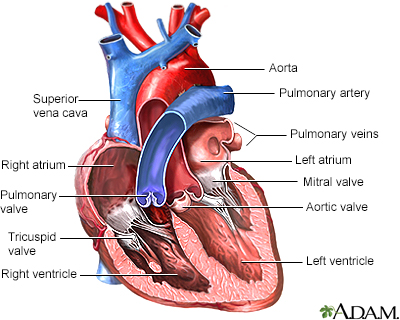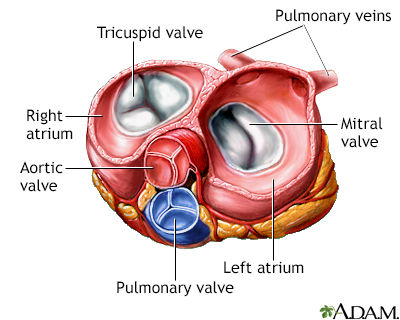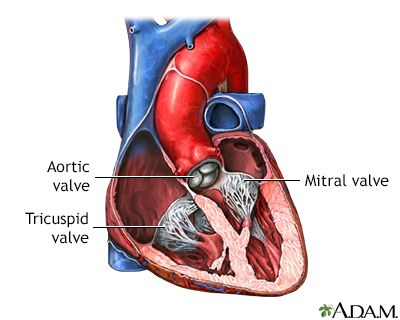Heart valve surgery
Valve replacement; Valve repair; Heart valve prosthesis; Mechanical valves; Prosthetic valves
Heart valve surgery is used to repair or replace diseased heart valves.
Blood that flows between different chambers of your heart must flow through a heart valve. Blood that flows out of your heart into large arteries must also flow through a heart valve.
These valves open up enough so that blood can flow through. They then close, keeping blood from flowing backward.
There are 4 valves in your heart:
- Aortic valve
- Mitral valve
- Tricuspid valve
- Pulmonic valve
The aortic valve is the most common valve to be replaced. The mitral valve is the most common valve to be repaired. Only rarely is the tricuspid valve or the pulmonic valve repaired or replaced.

The interior of the heart is composed of valves, chambers, and associated vessels.

The external structures of the heart include the ventricles, atria, arteries and veins. Arteries carry blood away from the heart while veins carry blood into the heart. The vessels colored blue indicate the transport of blood with relatively low content of oxygen and high content of carbon dioxide. The vessels colored red indicate the transport of blood with relatively high content of oxygen and low content of carbon dioxide.

There are four valves located in the heart. Each valve either consists of two or three folds of thin tissue. When closed, the valve prevents blood from flowing backwards to its previous location. When open the valve allows blood to flow freely. Valve problems can occur because of congenital abnormalities, infection, or other causes.

There are four valves located in the heart. Each valve either consists of two or three folds of thin tissue. When closed, the valve prevents blood from flowing backwards to its previous location. When open the valve allows blood to flow freely. Valve problems can occur because of congenital abnormalities, infection, or other causes.

There are four valves in the heart aortic valve, mitral valve, tricuspid valve, and pulmonary valve. The valves are designed to control the direction of blood flow through the heart. The opening and closing of the heart valves produce the heart-beat sounds.
Description
Before your surgery, you will receive general anesthesia. You will be asleep and unable to feel pain.
In open heart surgery, the surgeon makes a large surgical cut in your breastbone to reach the heart and aorta. You are connected to a heart-lung bypass machine. Your heart is stopped while you are connected to this machine. This machine does the work of your heart, providing oxygen and removing carbon dioxide.
Minimally invasive valve surgery is done through much smaller cuts than open surgery, or through a catheter inserted through the skin. Several different techniques are used:
- Percutaneous surgery (through the skin)
- Robot-assisted surgery
If your surgeon can repair your mitral valve, you may have:
- Ring annuloplasty. The surgeon repairs the ring-like part around the valve by sewing a ring of plastic, cloth, or tissue around the valve.
- Valve repair. The surgeon trims, shapes, or rebuilds one or more of the leaflets of the valve. The leaflets are flaps that open and close the valve. Valve repair is best for the mitral and tricuspid valves. The aortic valve is usually not repaired.
If your valve is too damaged, you will need a new valve. This is called valve replacement surgery. Your surgeon will remove your valve and put a new one in place. The main types of new valves are:
- Mechanical -- made of man-made materials, such as metal (stainless steel or titanium) or ceramic. These valves last the longest, but you will need to take blood-thinning medicine, such as warfarin (Coumadin) or aspirin, for the rest of your life.
- Biological -- made of human or animal tissue. These valves last 12 to 15 years, but you may not need to take blood thinners for life.
In some cases, surgeons can use your own pulmonic valve to replace the damaged aortic valve. The pulmonic valve is then replaced with an artificial valve (this is called the Ross Procedure). This procedure may be useful for people who do not want to take blood thinners for the rest of their life. However, the new aortic valve does not last very long and may need to be replaced again by either a mechanical or a biologic valve.
Related topics include:
Why the Procedure Is Performed
You may need surgery if your valve does not work properly.
- A valve that does not close all the way will allow blood to leak backwards. This is called regurgitation.
- A valve that does not open fully will limit forward blood flow. This is called stenosis.
You may need heart valve surgery for these reasons:
- Defects in your heart valve are causing major heart symptoms, such as chest pain (angina), shortness of breath, fainting spells (syncope), or heart failure.
- Tests show that the changes in your heart valve are beginning to seriously affect your heart function.
- Your doctor wants to replace or repair your heart valve at the same time as you are having open heart surgery for another reason, such as a coronary artery bypass graft surgery.
- Your heart valve has been damaged by infection (endocarditis).
- You have received a new heart valve in the past and it is not working well, or you have other problems such as blood clots, infection, or bleeding.
Some of the heart valve problems treated with surgery are:
- Aortic insufficiency
- Aortic stenosis
- Congenital heart valve disease
- Mitral regurgitation - acute
- Mitral regurgitation - chronic
- Mitral stenosis
- Mitral valve prolapse
- Pulmonary valve stenosis
- Tricuspid regurgitation
- Tricuspid valve stenosis
Risks
The risks of having cardiac surgery include:
- Death
- Heart attack
- Heart failure
- Bleeding requiring reoperation
- Rupture of the heart
- Irregular heartbeat (arrhythmia)
- Kidney failure
- Post-pericardiotomy syndrome -- low fever and chest pain that can last for up to 6 months
- Stroke or other temporary or permanent brain injury
- Infection
- Problems with the breastbone healing
- Temporary confusion after surgery due to the heart-lung machine
It is very important to take steps to prevent valve infections. You may need to take antibiotics before dental work and other invasive procedures.
Before the Procedure
Your preparation for the procedure will depend on the type of valve surgery you are having:
- Aortic valve surgery - minimally invasive
- Aortic valve surgery - open
- Mitral valve surgery - minimally invasive
- Mitral valve surgery - open
After the Procedure
Your recovery after the procedure will depend on the type of valve surgery you are having:
- Aortic valve surgery - minimally invasive
- Aortic valve surgery - open
- Mitral valve surgery - minimally invasive
- Mitral valve surgery - open
The average hospital stay is 5 to 7 days. The nurse will tell you how to care for yourself at home. Complete recovery will take a few weeks to several months, depending on your health before surgery.
Outlook (Prognosis)
The success rate of heart valve surgery is high. The operation can relieve your symptoms and prolong your life.
Mechanical heart valves do not often fail. However, blood clots can develop on these valves. If a blood clot forms, you may have a stroke. Bleeding can occur, but this is rare. Tissue valves last an average of 12 to 15 years, depending on the type of valve. Long-term use of blood thinning medicine is most often not needed with tissue valves.
There is always a risk for infection. Talk to your doctor before having any type of medical procedure.
The clicking of mechanical heart valves may be heard in the chest. This is normal.
References
Carabello BA. Valvular heart disease. In: Goldman L, Schafer AI, eds. Goldman-Cecil Medicine. 26th ed. Philadelphia, PA: Elsevier; 2020:chap 66.
Herrmann HC, Reardon MJ. Transcatheter therapies for mitral and tricuspid valvular heart disease. In: Libby P, Bonow RO, Mann DL, Tomaselli, GF, Bhatt DL, Solomon SD, eds. Braunwald's Heart Disease: A Textbook of Cardiovascular Medicine. 12th ed. Philadelphia, PA: Elsevier; 2022:chap 78.
Leon MB, Mack MJ. Transcatheter aortic valve replacement. In: Libby P, Bonow RO, Mann DL, Tomaselli, GF, Bhatt DL, Solomon SD, eds. Braunwald's Heart Disease: A Textbook of Cardiovascular Medicine. 12th ed. Philadelphia, PA: Elsevier; 2022:chap 74.
Nishimura RA, Otto CM, Bonow RO, et al. 2017 AHA/ACC Focused Update of the 2014 AHA/ACC Guideline for the Management of Patients With Valvular Heart Disease: A Report of the American College of Cardiology/American Heart Association Task Force on Clinical Practice Guidelines. Circulation. 2017;135(25):e1159-e1195. PMID: 28298458
Pellikka PA, Nkomo VT. Tricuspid, pulmonic, and multivalvular disease. In: Libby P, Bonow RO, Mann DL, Tomaselli, GF, Bhatt DL, Solomon SD, eds. Braunwald's Heart Disease: A Textbook of Cardiovascular Medicine. 12th ed. Philadelphia, PA: Elsevier; 2022:chap 77.
Rosengart TK, Aberle CM, Ryan C. Acquired heart disease: valvular. In: Townsend CM Jr, Beauchamp RD, Evers BM, Mattox KL, eds. Sabiston Textbook of Surgery. 21st ed. Philadelphia, PA: Elsevier; 2022:chap 61.
Version Info
Last reviewed on: 4/18/2022
Reviewed by: Mary C. Mancini, MD, PhD, Cardiothoracic Surgeon, Shreveport, LA. Review provided by VeriMed Healthcare Network. Also reviewed by David C. Dugdale, MD, Medical Director, Brenda Conaway, Editorial Director, and the A.D.A.M. Editorial team.
